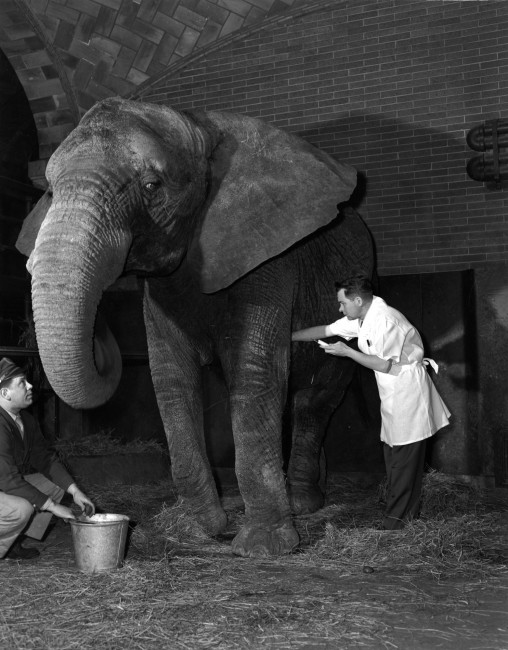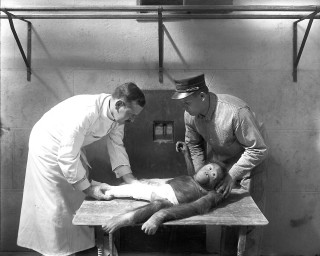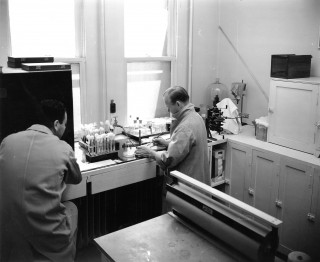
October 15, 2020
A Tradition of Excellent Veterinary Care: Leonard Joyce Goss
- as seen by -
 Paul P. Calle
Paul P. Calle
The Wildlife Conservation Society’s (then the New York Zoological Society) Bronx Zoo opened to the public on November 8, 1899. Dr. Leonard Joyce Goss was the zoo’s fourth full-time veterinarian serving from 1939-1952 when he became the Bronx Zoo’s Assistant Director from 1952-1958. He then left WCS to become the director of the Cleveland Zoo.
Dr. Goss was a graduate of The Ohio State University Veterinary School. After graduation he held the position of Assistant Poultry Resident providing veterinary support for poultry at Cornell University Veterinary School while pursuing his PhD in Pathology, and then continued there as an Instructor in Pathology after receiving his PhD. He continued to have a strong interest in pathology throughout his Bronx Zoo career.
During his time as veterinarian, he emphasized preventive medicine, nutrition, the provision of research samples to collaborators, and the value of both pathology and practical research (including determination of primate blood groups) for optimal animal health. In 1940, the title of veterinarian was changed to Curator of Health, reflecting a broadening of the role to include supervision of food and sanitation of public facilities and training in sanitation for keepers. These new responsibilities resulted in hiring a registered nurse to provide first aid for guests and employees, and to be a hospital technician conducting animal laboratory and research.
A research assistant position was created, and he established and strengthened relationships with local public and private research laboratories, hospitals, and universities. Medical care was enhanced by utilization of new anesthetic drugs and treatment with recently developed sulfonamides and other antibiotics. Installation of glass in primate exhibits to prevent transmission of TB from people to animals, and ongoing testing programs to control the disease, dramatically decreased the cases of TB in Bronx Zoo animals. Exhibit design and preventive medical strategies to ensure the health of our animals are still priorities for us today. Limitations of food in the war years resulted in ongoing diet adjustments, based on availability of various food items, to keep our diverse species in good health. Zoo outbreaks of Canine Distemper in small mammals and Feline Panleukopenia in cats were controlled with routine vaccination for these diseases, procedures that we still employ today. The Bronx Zoo’s first fluoroscopy equipment (a specialized x-ray machine) was ordered during his tenure to advance existing diagnostic capabilities.
Throughout his career, Goss was active in professional organizations, becoming president of the New York City Veterinary Medical Association, and he frequently gave talks at professional meetings to share information about zoo veterinary care. In recognition of his leading role in this area, he was appointed Chair of the American Veterinary Medical Association’s Special Committee on Disease of Wild Animals and he was elected a charter member in the founding of the American College of Veterinary Pathology. He hosted extensive national and international visitors from zoos, veterinary organizations, public health agencies, the United States Fish and Wildlife Service, and veterinary schools. In 1949, Dr. Goss initiated a summer Veterinary Fellowship program at the Bronx Zoo for graduate veterinarians, a predecessor of our existing veterinary student externship and graduate veterinary residency programs reflecting our longstanding commitment to developing the next generation of zoo veterinary professionals.
Receiving 189 animals from the Belgian Congo in 1949, including an okapi, resulted in challenges to treat parasites and diseases of these novel species, and due to the excellent care they received they did very well. In 1951, there were federal changes in the quarantine method for birds to prevent psittacosis and other diseases that resulted in new procedures for acquisition of birds by the zoo. A notable case in his Bronx Zoo tenure was the successful treatment of tetanus in an elephant that required intensive care. Dr. Goss (on the right above) is preparing to treat the elephant while Bronx Zoo Mammalogy Keeper Bob Montana feeds her treats to distract her from the treatments. Bob worked for WCS for 50 years, ending his Bronx Zoo career working in the animal hospital where I worked with him.
Since Dr. Goss’s time, we have continued a proud tradition of excellent veterinary care for our animals led by a succession of veterinarians who have been leaders in the field and set an example of high standards for zoo animal health care. I am the ninth Bronx Zoo Chief Veterinarian and in the coming months I look forward to sharing with you information and images of the Wildlife Conservation Society’s long history of innovative animal health care provided by our dedicated animal health department, led by the Chief Veterinarian.
EDITOR’S NOTE: The Wildlife Conservation Society is celebrating 125 years of saving wildlife and wild places in 2020. WCS was founded as the New York Zoological Society in 1895, and the flagship Bronx Zoo opened in 1899. Wild View will feature regular posts on the history of the Society’s photography and other events throughout the year.




Leave a Comment
Christopher Montana
December 19, 2023 at 2:34 pm
What a joy to see pictures of my father, Bob Montana, in these articles about the WCS, Bronx Zoo and the story about Dr. Leonard Goss. It’s hard to believe that my father worked at the zoo for 50 years and seemed to enjoy his time at this marvelous institution.